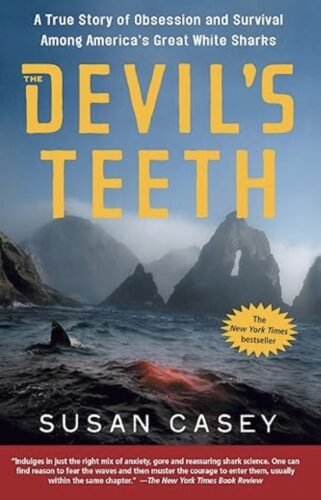
I think it’s safe to write about sharks after Labor Day. I try not to do this earlier on in the summer for obvious reasons. It isn’t nice doing it early on. We all like sharks but we all like the beach too. I watched Jaws for the umpteenth time the other night and just thought, “Nope.”
Susan Casey appears to not have these thoughts. She is an editor and sports writer for outdoor magazines like Outside and Sports Illustrated. She was the editor in chief of O, the Oprah Magazine. She has written extensively for Time, Esquire, and is the author of some great books.
She is brave. “Nope” probably isn’t in her vocabulary. She climbs and dives. She seeks adventure, especially in the water. She has explored the Mariana Trench among other exceedingly deep parts of the ocean.
In November of 2000, she secured an invitation to travel to the Farallones islands west of San Francisco. The Farallones are a 211-acre archipelago 27 miles west of the city and the gathering spot for the largest congregation of Great Whites in the world each September through November. It is home to the Farallones White Shark Project led by Scot Anderson and Peter Pyle .
Getting an invitation/permit wasn’t easy. Very few outsiders are allowed and initially she is only granted a US Fish and Wildlife media pass. But when they motor out in a whaler and come face to face with the sharks, she’s all in.
She will do whatever it takes to come back. “… I lost track of time, crouched in the whaler’s scooped-out bow, bouncing from one railing to the other while the massive fish cruised under us like submarines; I could have kept it up, I think, forever.”
She travels to the nearby town of Port Reyes, to check in with Scot and Peter as often as she can and develops a friendship with the two men . There are conflicts with tourism operations and government operations.
People want to cage-dive, to see the “monsters of the deep” for themselves. People want to dive for abalone [highly-prized marine snails.] Other scientists are studying the birds on the islands. It has become a very complicated political /financial web to navigate.
In 2003 she gets a weeklong pass to stay if she writes an article about the birds. She agrees. Her accounts are scientifically fascinating. Detailed but not boringly so. Her personal stories are wonderful.
It takes a strong, colorful personality to survive on a poop-covered, man-eater-surrounded, cold, wet, isolated rock for months at a time. And, oh, there’s a ghost. (Susan immediately regrets bringing an antique ouiji board for example.)
It should be an horrific, miserable, nasty experience but it’s not. It’s majestic. It’s ethereal. It’s incredible.
Or to put it another way, to quote both the book and German poet Rainer Maria Rilke, “ Every angel is terrifying.”

About the author: Jen Petty Hilger grew up in New York and London, England, but finds herself happily quiet living by the water in Old Lyme. She and her husband have six children between them and a myriad of rescued animals.